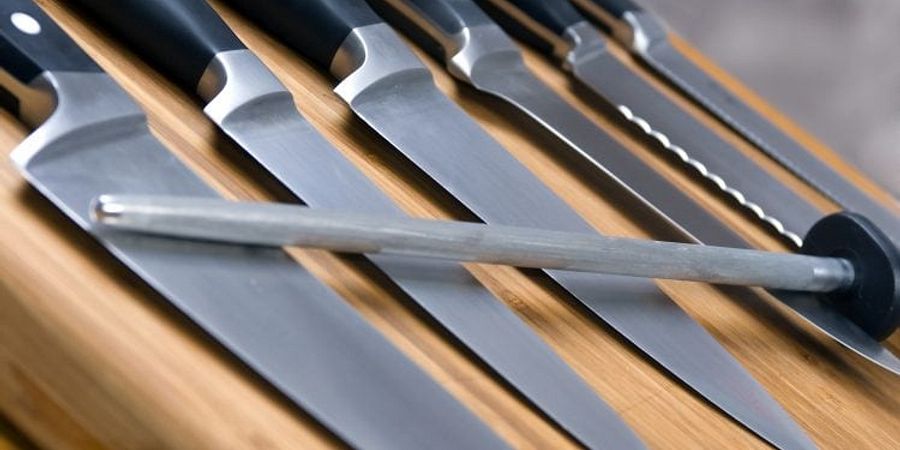Slice it Right: Essential Kitchen Knives For a Commercial Kitchen

As a painter needs the right tools to create a masterpiece, a master chef needs the right tools to create a culinary masterpiece.
Of course, there are hundreds of weird kitchen gadgets out there. But there are only a few basics that are absolutely necessary, especially in the hands of a skilled chef.
Today we'll be focusing on knives. Which are the essential kitchen knives that every commercial kitchen needs? Let's find out!
The Big Three Essential Kitchen Knives
Though there are a variety of knives to choose from, there are three that stand out as being essential for every commercial kitchen. We'll talk about those, and then mention a few others that may be useful to you depending on the type of food that you serve.
1. Chef's Knife
Ask any chef what one knife they simply couldn't live without and this would be it. The chef's knife is the quintessential kitchen tool when it comes to knives. Some chefs go so far as to say they don't need any other knives, they can accomplish everything with this one incredible knife.
What makes the chef's knife so great? Let's look!
Though you can get chef's knives in varying lengths, most commonly they fall between 8 to 10 inches long. The blade is wide and its primary purposes are chopping, slicing, and dicing.
There are two styles--French and Japanese. The most traditional is the French style which has a blade that curves up to the tip. Many chefs, however, prefer the Japanese style whose tip curves down a bit.
2. Paring Knife
Think of a paring knife as a miniature chef's knife. This handy tool is perfect for smaller needs where a chef's knife would be too big and cumbersome.
The blade is typically only about 3-4 inches long. Thus making it perfect for peeling, trimming vegetables and slicing small, soft fruits like strawberries.
Some chefs still prefer to use their trusty chef's knife for these jobs. However, even in skilled hands the risk of injury rises because it's a little awkward to manipulate such a large blade like that.
3. Serrated or Bread Knife
A serrated knife packs the punch that is missing from a chef's knife, even a sharp one. Have you ever tried to slice a piece of crusty bread with a smooth knife? You probably butchered the soft inside of the bread in the process of trying to get through the crunchy crust.
A serrated knife slices through the tough crust in one smooth motion without destroying the soft interior. This knife also works well for soft produce like tomatoes or eggplant, especially if you want to slice them super thin.
Specialty Knives
Depending on the type of food you serve there are also a few types of knives that will come in handy. Let's take a look at some of them.
1. Cleaver
The cleaver is the big heavy knife that seems to like to make an appearance in horror movies and as part of Halloween costumes. But in the kitchen, it can be a very versatile knife.
The blade is big, heavy, and rectangular. For someone who doesn't know how to use it, it can be cumbersome and awkward to use. However, a skilled chef can use it almost the same as a chef's knife.
Because the blade is so wide it is effective for scooping up chopped pieces, making it easy to toss them in your container. This helps for when it's time to clean up!
It's weight also gives it the added bonus of being able to smash and slice through bones easily on big hunks of meat. That's probably why it's such a great prop for horror movies.
2. Carving Knife
The carving knife is another useful knife for cutting up meats. Also called a slicing knife, this is a long, narrow knife designed for slicing through meats. It is thin and flexible, making it easier to thinly slice a roast or turkey.
This knife is very handy when the presentation of your meat is important. Of course, if you serve meat in your restaurant, it's presentation is always important. After all, how food looks actually does affect its taste--or at least, our perception of its taste.
3. Boning Knife
If you own a seafood restaurant, a boning knife is a must for your kitchen. This type of knife is generally only about 6 inches long. But it is very thin and flexible, making it ideal for the delicate task of removing bones from raw meat.
We mentioned that it's useful for seafood. You'll definitely need to remove those tiny bones so your customers don't choke! However, a boning knife is also useful for removing bones and skin from poultry as well.
If you run a vegetarian/vegan restaurant you can probably get away with not having this knife in your kitchen. But if you ever need to cleanly cut bones away from meat, this knife is an absolute must.
Which Will Make the Cut?
As you can see, the essential kitchen knives for your kitchen will depend on the type of food you serve. We hope this guide has given you an idea of what you'll need to budget for.
Don't be afraid to buy quality knives. These are tools that chefs constantly will be using. With the right tools they can more easily, and safely, prepare delightful dishes that are sure to wow your customers. That makes them worth every penny!
Share This!